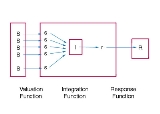
Information Integration Theory
Encyclopedia
Information integration theory was proposed by Norman H. Anderson
to describe and model how a person integrates information from a number of sources in to make an overall judgment. The theory proposes three functions.
The valuation function V(S) is an empirically derived mapping of stimuli to an interval scale. It is unique up to an interval transformation (y = ax + b).
The integration function r = I{s1,s2, .. ,sn} is an algebraic function combining the subjective values of the information. "Cognitive algebra" refers to the class of functions that are used to model the integration process. They may be adding, averaging, weighted averaging, multiplying, etc.
The response production function R = M(r) is the process by which the internal impression is translated into an overt response.
Information integration theory differs from other theories in that it is not erected on a consistency principle such as balance or congruity but rather relies on algebraic models.
Adding models
R = reaction/overt behavior
F/G = contributing factors
R1 = F1 + G1 (Condition 1)
R2 = F2 + G2 (Condition 2)
Typically an experiment is designed so that:
R1 = R2, and
F1 > F2, so that
G1 < G2
There are two special cases known as discounting and augmentation.
Discounting: The value of any factor is reduced if other factors that produce the same effect are added.
Example: F2 is not present or has a value of zero. If F1 is positive, then G1 must be less than G2.
Augmentation: An inverse version of the typical model.
Example: If F1 is negative, then G1 must be greater than G2
Two advantages of adding models; (1) Participants are not required to have an exact intuitive calculation, (2) The adding model itself need not be completely valid. Certain kinds of interaction among the factors would not affect the qualitative conclusions.
Norman H. Anderson
Norman Henry Anderson is a social psychologist, and Distinguished Professor Emeritus at the University of California, San Diego, where he was one of three founders of the Department of Psychology...
to describe and model how a person integrates information from a number of sources in to make an overall judgment. The theory proposes three functions.
The valuation function V(S) is an empirically derived mapping of stimuli to an interval scale. It is unique up to an interval transformation (y = ax + b).
The integration function r = I{s1,s2, .. ,sn} is an algebraic function combining the subjective values of the information. "Cognitive algebra" refers to the class of functions that are used to model the integration process. They may be adding, averaging, weighted averaging, multiplying, etc.
The response production function R = M(r) is the process by which the internal impression is translated into an overt response.
Information integration theory differs from other theories in that it is not erected on a consistency principle such as balance or congruity but rather relies on algebraic models.
Integration models
There are three main types of algebraic models used in information integration theory: adding, averaging, and multiplying.Adding models
R = reaction/overt behavior
F/G = contributing factors
R1 = F1 + G1 (Condition 1)
R2 = F2 + G2 (Condition 2)
Typically an experiment is designed so that:
R1 = R2, and
F1 > F2, so that
G1 < G2
There are two special cases known as discounting and augmentation.
Discounting: The value of any factor is reduced if other factors that produce the same effect are added.
Example: F2 is not present or has a value of zero. If F1 is positive, then G1 must be less than G2.
Augmentation: An inverse version of the typical model.
Example: If F1 is negative, then G1 must be greater than G2
Two advantages of adding models; (1) Participants are not required to have an exact intuitive calculation, (2) The adding model itself need not be completely valid. Certain kinds of interaction among the factors would not affect the qualitative conclusions.

